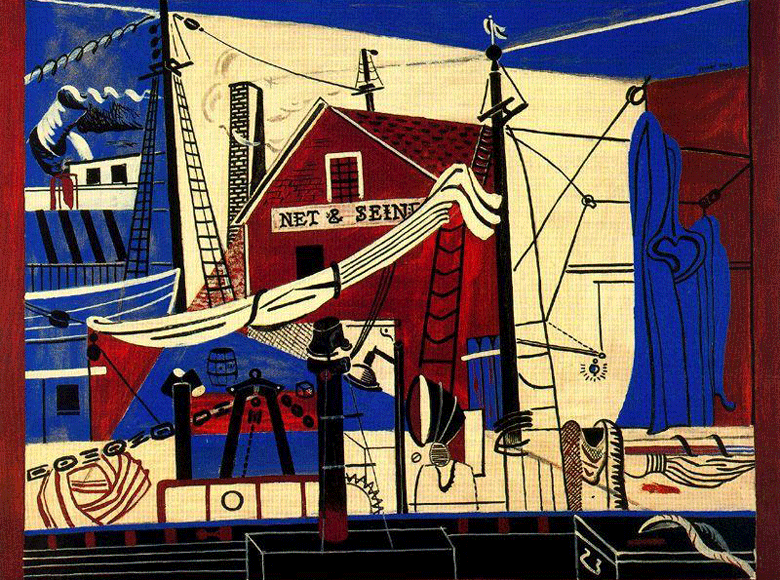Located 25 or so miles northeast of Boston on Cape Ann, Gloucester is among the busiest fishing ports on the East Coast. An important shipbuilding center dating back to the early 1700s, over time the town became the hub for a fishing fleet that frequented the Grand Banks.
Gloucester was (and remains) an artist magnet, attracting esteemed painters over the years, among them, Fitz Henry Lane, Winslow Homer, Childe Hassam, Edward Hopper, Cecilia Beaux, and Nell Blaine. A large part of its allure derives from its waterfront.
By the time Stuart Davis painted Landscape with Drying Sails in 1931-1932, he was a longtime Gloucester summer resident, having first visited in 1915 at the invitation of fellow painter John Sloan, whose red cottage in East Gloucester served as a kind of boarding house for artists.
Based in New York City, Davis sought respite from summer heat by retreating to the sea. Lucky for us, his getaways led to some memorable canvases.
He embraced new ways of representing the world and became renowned for his modernist paintings in which he appeared to improvise…
At age 23 Davis had been one of the youngest painters in the groundbreaking 1913 Armory Show, which introduced Americans to innovative European art trends, including Cubism.
He embraced new ways of representing the world and became renowned for his modernist paintings in which he appeared to improvise—not a surprise, as he adored jazz. When he looked at the bustling Gloucester waterfront, he saw a medley of marine subjects and set out to render it as a collage-like composition.
Ben Fuller, Penobscot Marine Museum curator, helps identify some of the elements of the painting. The central craft is an Eastern rig dragger or trawler, which, he explains, “took the place of the sailing dory, which used hooks, lines, and bait.” Fishermen dragged a net over the side from two points, the drying sail serving as a “steadying sail…as these vessels were all engine powered.”
Moving left to right, the upside-down V-shaped object is the net hauler while “the black thing with the funny cap,” called a Charlie Noble, might be the stove pipe. The “toothy” object is part of the winch system to haul the net; the short, curved horn near the middle of the deck is the ventilator or air intake. The hoisted-up blue shape on the right could be a net drying.
“I think the mast to the left belongs to a different boat,” Fuller surmises, “but [the painter] has moved stuff around so it’s hard to tell.”
The name of the business, Net and Seine, may be based on the Gloucester Net and Twine Company, founded in 1884. A photograph of the building features a smokestack similar to the one that appears in the painting.
You can trace the evolution of Davis’s aesthetic through his Gloucester paintings, from early post-Impressionist studies to the lively modernist works for which he is best known. The later paintings influenced future generations, including Maine’s own Francis Hamabe, who credited Davis with inspiring his jazz-oriented approach to landscape.
The art of Davis and Hamabe reflects their passion for that dynamic milieu that is the working waterfront.
For more information about Davis in Gloucester, check out the Cape Ann Museum website.
Carl Little’s most recent book is Mary Alice Treworgy: A Maine Painter (Marshall Wilkes).





